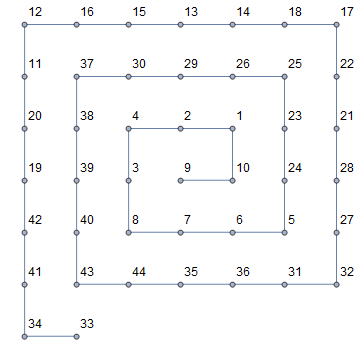While working to self-answer FindCurvePath for lines (rather than points) using Graph functions I came upon a seemingly silly conundrum: how do I programmatically list the vertex names of a PathGraph-like-graph in order? For example I have:
How can I extract {9, 10, 1, 2, 4, ..., 41, 34, 33} from this?
I am using version 10.1.0 and I do not have FindHamiltonianPath as proposed by Jason. I suppose that is the canonical approach in recent versions.
Code:
Graph[{1, 2, 3, 4, 5, 6, 7, 8, 9, 10, 11, 12, 13, 14, 15, 16, 17, 18, 19, 20, 21, 22, 23, 24, 25, 26, 27, 28, 29, 30, 31, 32, 33, 34, 35, 36, 37, 38, 39, 40, 41, 42, 43, 44}, {Null, SparseArray[Automatic, {44, 44}, 0, {1, {{0, 2, 4, 6, 8, 10, 12, 14, 16, 17, 19, 21, 23, 25, 27, 29, 31, 33, 35, 37, 39, 41, 43, 45, 47, 49, 51, 53, 55, 57, 59, 61, 63, 64, 66, 68, 70, 72, 74, 76, 78, 80, 82, 84, 86}, {{2}, {10}, {1}, {4}, {4}, {8}, {2}, {3}, {6}, {24}, {5}, {7}, {6}, {8}, \ {3}, {7}, {10}, {1}, {9}, {12}, {20}, {11}, {16}, {14}, {15}, {13}, {18}, {13}, \ {16}, {12}, {15}, {18}, {22}, {14}, {17}, {20}, {42}, {11}, {19}, {22}, {28}, {17}, \ {21}, {24}, {25}, {5}, {23}, {23}, {26}, {25}, {29}, {28}, {32}, {21}, {27}, {26}, \ {30}, {29}, {37}, {32}, {36}, {27}, {31}, {34}, {33}, {41}, {36}, {44}, {31}, {35}, \ {30}, {38}, {37}, {39}, {38}, {40}, {39}, {43}, {34}, {42}, {19}, {41}, {40}, {44}, \ {35}, {43}}}, Pattern}]}, {VertexLabels -> {"Name"}}] 

FindHamiltonianPath@g? $\endgroup$